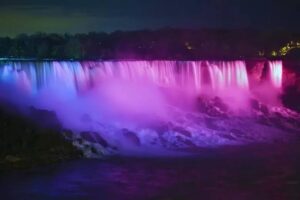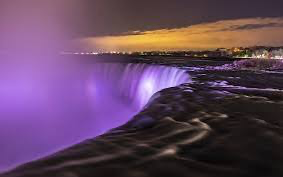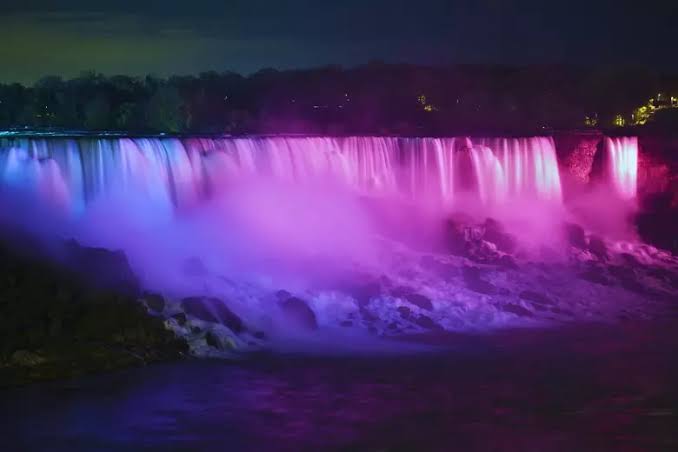Niagara Falls Appears to Turns Purple; Here’s Why Read More: Niagara Falls Appears to Turns Purple;
Niagara Falls Turns Purple: The Science and Significance Behind This Phenomenon
Niagara Falls, one of the most iconic natural wonders in the world, is known for its breathtaking views and its captivating beauty. Located on the border between the United States and Canada, this immense waterfall has attracted millions of visitors every year. Typically, visitors are greeted with the magnificent sight of the Falls tumbling over the edge of a cliff, sending mist into the air and creating rainbows in the sunlight. But what if the Falls turned purple? Recently, a phenomenon took place where Niagara Falls appeared to turn purple, sparking curiosity and awe among those who witnessed it. While it might seem like a magical occurrence, there’s actually a very scientific explanation behind this color shift. In this article, we will explore why Niagara Falls turned purple, the possible reasons for this, and the broader implications of such events.

1. The Causes of the Purple Hues at Niagara Falls
Niagara Falls’ typical appearance is a mixture of deep blues and greens, owing to the minerals in the water and the way sunlight reflects off the surface. However, the appearance of purple hues in the Falls is a rare and striking event, and the cause is often linked to one or a combination of external factors that influence how we perceive the water’s color.
Light Shows and Special Effects
The most straightforward explanation for the purple appearance of Niagara Falls is the use of lighting during special events. For example, on certain occasions, Niagara Falls is illuminated by colored lights to mark a celebration, holiday, or awareness campaign. The Falls have long been a canvas for such light displays, ranging from the national colors of Canada and the United States to special rainbow-colored lights. On some occasions, these lights are specifically adjusted to project a purple hue.
This effect is particularly noticeable during events like Purple Day, an event dedicated to raising awareness about epilepsy. During such campaigns, the Falls are bathed in purple lights, symbolizing support for epilepsy awareness and other causes. The lights interact with the mist and the water droplets, creating a stunning visual effect that can make the Falls appear to glow in shades of purple. This has become an annual tradition, and many people travel to Niagara Falls specifically to witness this spectacle.
Environmental Factors and Atmospheric Conditions
Another potential reason for Niagara Falls turning purple could be linked to specific environmental conditions, such as the angle of the sun, the time of day, and the presence of particulate matter or pollution in the air. At certain times of day, especially during the late afternoon or early evening, the sunlight interacts with the mist from the Falls, causing a change in the color perception of the water. The mist droplets refract light in different ways, creating a rainbow-like effect that can sometimes skew towards purple, depending on the light conditions.

Additionally, atmospheric conditions such as the presence of smoke, dust, or other particles in the air can also influence how light is scattered and reflected by the water. On rare occasions, these environmental factors can combine in a way that makes the Falls appear to take on a purple hue, creating an otherworldly visual experience. While this may not be a common occurrence, it is certainly an intriguing aspect of the Falls that further adds to its mystique.
2. The Cultural and Symbolic Significance of Purple
Purple is often associated with meanings of power, mystery, and spirituality, and it has long been regarded as a color that signifies rarity and exclusivity. The use of purple lights to illuminate Niagara Falls holds symbolic meaning, particularly for causes like epilepsy awareness, as well as for other special events and observances.
Epilepsy Awareness
One of the most notable occasions when Niagara Falls turns purple is on Purple Day, which occurs annually on March 26th. Purple Day was founded in 2008 by a young girl named Cassidy Megan from Nova Scotia, Canada, to raise awareness about epilepsy. Since then, Niagara Falls has participated in the event by lighting up the Falls in purple. This simple yet powerful gesture brings attention to epilepsy, a neurological disorder that affects millions of people worldwide, and encourages education and understanding about the condition.
Other Cultural Associations
In many cultures, purple is also linked to nobility and royalty, as the dye historically used to create the color was expensive and rare. The association of purple with royalty may lend a sense of grandeur to the event, making it an even more awe-inspiring sight. Furthermore, purple is also seen as a color of creativity and imagination, and its appearance on Niagara Falls can evoke feelings of wonder and mystery.
3. The Role of Niagara Falls as a Global Icon
Niagara Falls is not only an important natural landmark; it also plays a significant role in various cultural, social, and environmental contexts. The Falls have long been a symbol of strength, endurance, and the power of nature, attracting millions of tourists each year. The Falls’ ability to appear different during various times of the day, seasons, and events further adds to its appeal and mystique.
When the Falls turn purple for a cause, such as raising awareness for epilepsy, it helps transform the natural wonder into a symbol of social advocacy and solidarity. These light displays and environmental changes represent a shift in how people interact with the natural world, suggesting that human creativity and awareness can merge with the grandeur of nature to bring about positive change.
4. The Science of Water, Light, and Color Perception
Understanding why Niagara Falls can sometimes appear to change colors comes down to the science of light and color perception. The mist from the Falls is made up of tiny water droplets that refract and scatter light, breaking it into its various wavelengths. When light hits these droplets, it behaves like a prism, dispersing the light into its component colors.
Under certain conditions, especially when colored lights are employed or specific atmospheric conditions occur, certain wavelengths of light—especially those in the purple and violet range—can become more pronounced. The composition of the water itself and the way it refracts light can enhance this effect, making the Falls appear to glow in shades of purple, further adding to the spectacle.
5. Conclusion
The phenomenon of Niagara Falls turning purple is a striking and mesmerizing event, driven by a combination of environmental conditions, light displays, and cultural significance. Whether as part of a campaign to raise awareness for epilepsy or as a result of unique lighting effects, the purple hues add a new dimension to the Falls’ allure and serve as a reminder of the power of human creativity and social responsibility.
While the natural beauty of Niagara Falls is breathtaking in its own right, events like these remind us that even the most iconic landmarks can take on new meanings when seen through the lens of human connection, advocacy, and artistic expression. The purple-lit Falls will continue to be a beacon of both natural wonder and social awareness, providing both a visual and emotional impact for all who witness this extraordinary sight.






